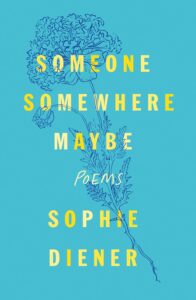Whether it’s poetry by Walt Whitman or Edgar Allan Poe, children’s poetry by Shel Silverstein, or poetry by singers like Jewel and Halsey, everyone can agree that poetry is meant to make you feel something, whether it’s deeply vulnerable, beautiful, or side-splittingly funny. But in the past few years especially, vulnerable and confessional poetry has become increasingly more popular as readers take comfort from poems about love, loss, and identity amidst lovely images of flowers and more—and the latest to this family of poets is TikTok sensation Sophie Diener.
Her debut collection, Someone Somewhere Maybe, will be perfect for anyone who enjoys personal poetry, confessional poetry, and poetry that encourages emotional reflection, perhaps even for journaling. Fans of Rupi Kaur, Amanda Lovelace, Cleo Wade, and honestly, even Taylor Swift, will absolutely feel at home among Sophie Diener’s poems.
 The collection proves to be relatable (in the best way) as Diener broaches familiar topics like the experience of first love, a relationship ending, grief, identity, and self-worth. It’s a beautiful reflection of not only the human condition but the importance of showing ourselves, and those around us, grace.
The collection proves to be relatable (in the best way) as Diener broaches familiar topics like the experience of first love, a relationship ending, grief, identity, and self-worth. It’s a beautiful reflection of not only the human condition but the importance of showing ourselves, and those around us, grace.
What really struck me throughout the collection were subtle repetitions that I know were deeply intentional: ghosts, haunted houses, or the transformation of a house. A ghost is something easy to remember, so it creates an echo for the reader of an earlier poem that may have also mentioned a ghost or something like it. These moments were important to me, as they also mimic how our minds work and how memories echo back through other things. While we may not always be consciously thinking of a past loved one or how we lost them, we remember them through other, smaller things. We’re called to remind lessons that we’ve learned, and how we’ve grown, through the site of a certain flower or a distinct smell of bread. Our memories are surprising and can come up at any time, just like the echoes found in these poems, which I found to be both an enriching feature and an endearing one.
Moving away from the content of the collection, I also loved Diener’s control in this collection through her visual elements. Poets generally have a very distinct idea in their mind of how they hope their readers will read their poems in the sense of pacing and pauses. Diener managed to control these through her succinct use of white space and asterisks to break up the moments in her poems, as well as intriguing choices in her enjambment. Her visual selections were fascinating to the eye, but they also assisted in the reading of the poems, like someone leading us expertly, if delicately, through a dance.
The overall message of the collection was powerfully rooted in grace, self-love, and our defined worth. Rather than placing our meaning in our appearances or how much money we make, the size of the beautiful house our ex ended up living in compared to our own, or how we imagined our lives going differently—it’s better for us to show ourselves grace and to practice gratitude through the little, beautiful, and kinder things in life and in nature. It’s fitting, then, referring back to how Diener controlled her poems through their presentation on the page, that in an entire collection of poems that were written in italics, the only moment in the collection where italics were not used was for the words, “You are loved.” Not only is this a point delivered over and over again throughout these poems, by various means and messages, but the reader, too, has to face it in standard text.
Sophie Diener’s Someone Somewhere Maybe is a beautiful and raw examination of the human condition, and it’s easily related to by all readers. Those in need of a warm hug, a good listening ear, and someone who understands them would love this book. Poets and those who love poetry will love this book, Diener’s turns of phrase, and her use of the page. And again, those who love Rupi Kaur and Taylor Swift, as well as Cleo Wade and Amanda Lovelace, and we’ll throw in the nostalgic fans of poetry by Jewel and Halsey, too—they’re going to absolutely love Someone Somewhere Maybe by Sophie Diener.
Sophie Diener’s Someone Somewhere Maybe is out now. You can order your copy, or one for a friend!, below:
Someone Somewhere Maybe (Paperback) Someone Somewhere Maybe (eBook) Someone Somewhere Maybe (Audiobook)
Keep reading for Lit Shark’s exclusive interview with Sophie Diener about Someone Somewhere Maybe and the poet’s writing life.
In Conversation with Sophie Diener
McKenzie Lynn Tozan (MLT): Hi Sophie! Thank you so much for sharing Someone Somewhere Maybe with me and for talking with me and the rest of the Lit Shark community. We’re so happy to have you.
Sophie Diener (SD): I’m happy to be here!
MLT: The story arc of this collection was so relatable—from the first love to the second, more complicated, love, to grief, to healing, to self-love. I’d love to hear more about your process of deciding that all of these poems belonged in the same collection, and how you decided how to order the poems, as they are not linear (impressively reflecting how our memories work, as well).
SD: I wanted this collection to capture some of what I felt and experienced in my late teens and early twenties. This is a period that can hold a lot of change and growth. As I’ve grown, I haven’t always experienced those feelings of love, grief, healing, and self-love in a linear way. Sometimes I make big leaps forward or take steps back. Sometimes my perspective shifts on things that happened a long time ago. I wanted the order of the poems to reflect that.
MLT: I loved the recurring theme of haunting, from the “Haunted House” to the intangible things people leave us in “Blue” to even wanting to remember these things to remind ourselves they happened/they were alive in “I’ll Think of You.” How did the concept of haunting come up for you? Has it continued to pop up in your work after this collection?
SD: I grew up in a very small town, and that’s also where I wrote the majority of my book. There aren’t many places I could go now in that town that I haven’t already been to countless times. As a result, when I’m in the area, I can see younger versions of me everywhere. When I’m in a gas station, for example, I might visualize my middle school self and her friends coming through the door with just enough change for slushies. One way I found to explain that concept was through the imagery of ghosts or haunting. It’s a concept I’m fond of, so it does continue to come up in my work.
MLT: Speaking of the intangible things given by past loved ones, would you be willing to share something intangible that was given to you that you’ve kept, like a book or movie recommendation that stays with you?
SD: This question made me think of so many lovely memories! I had a teacher tell me once that the song “The Light” by Regina Spektor made her think of me. I don’t think I’d ever forget someone telling me something like that. I hadn’t heard the song before, but I listened to it then and have loved it ever since.
MLT: Your use of italics throughout this entire collection was fascinating, and the moment of “You are loved” being in the standard font was such a powerful reminder. How did you make the decision to use italics throughout?
SD: I used italics to indicate where dialogue, real or imagined, was happening. I initially tried it out because I was worried quotation marks would seem lost in line breaks. I thought it worked well and made certain moments more powerful, so I continued using it.
MLT: You have this incredible talent for playing to pauses and using asterisks to assist in the readings of those pauses. I loved how your work lends itself to a thoughtful reading pace when reading alone, but also the possibility it has to be lent to spoken word. What has your journey to writing to pauses been like?
SD: When I first started writing poetry, I was actually viewing it more as spoken word because that’s what initially interested me. I was writing to achieve a certain sound. This was encouraged by the support I was receiving on TikTok, where I was posting videos of myself reading my work aloud. When I began this book, I became much more conscious of how it looked on paper without my voice there to accompany it. That’s when I started exploring different ways to create visual pauses.
MLT: On the surface, this collection is very much about the love found in relationships and grief at their ending, but it proves to be a tremendous project of personal growth, self-improvement, personal healing, and self-love. It’s beautiful. Were the poems written more so in reaction to events going on in your own life?
SD: Some of these poems are written in the voice of a younger version of me, while others are written to my younger self. I wanted to do both so that I could occasionally speak from different perspectives. I titled the book Someone Somewhere Maybe because I also wrote stories that I imagine could have happened to someone else, somewhere else. I used all of these methods to paint that non-linear healing and self-discovery journey that I think is common among young adults in their late teens and early twenties (and that I certainly see in my own past).
MLT: I loved and deeply identified with your introduction where you described your relationship with words; my journey was very similar! Now that you have published your first book, how would you say your relationship with words has changed or grown?
SD: Writing is still everything it has always been to me–a means to remember, feel better, and exercise my creativity–but now I’ve also learned of its power to nudge me out of my comfort zone. I worried when I first started writing my book that I wouldn’t be able to finish, but now that I’m here I feel stronger, braver, and more confident. I’m so grateful I had the opportunity to use words in this way!
MLT: A question we get a lot is about our routines, our inspiration, and how we get the work done. What’s your routine for writing poetry like? Where else do you draw inspiration from besides fellow poets? How DO you get the work done?!
SD: This is something I’m still figuring out! For so long, creative writing was something I did whenever I wanted, solely for enjoyment or stress relief. Writing a book was of course a completely new experience; I had to learn how to view writing as work and how to do it when I didn’t necessarily feel like it. In addition to being an author, I’m a teacher, so the summers are great for writing whenever inspiration strikes.
During the rest of the year, I’ve found it’s helpful to reserve periods of time in the evenings and on weekends to sit down with limited distractions and write, even if it’s nothing I end up liking. As for inspiration, I’ve found that it can come at any time in any place, so I’m always open to that and ready to pull out my phone, a notebook, or even a grocery store receipt to jot down ideas.
MLT: What’s one tip you would like to give your younger writer self (of any age or writing stage)?
SD: I can direct this tip to every version of my younger writer self: keep sharing! I am grateful for every moment I let someone else see my work. It has felt scary every time, but what I’ve experienced because of it has made it so worth it.
MLT: Finally, what are you working on now? Is there anything you can share with us?
SD: I’m currently working on writing poetry that is relevant to the stage of life I’m in now. My life has changed so much in some ways from when I wrote the first poem of Someone Somewhere Maybe. I am so grateful for the journey so far and am excited to see what will come next!
MLT: We’re so excited to see more of your work, Sophie! Thank you again, so much, for talking with us today!
Watch and Listen to One of Sophie’s Poems Below:
And Don’t Forget to Order Your Copy of Someone Somewhere Maybe Below:
Someone Somewhere Maybe (Paperback) Someone Somewhere Maybe (eBook) Someone Somewhere Maybe (Audiobook)
 SOPHIE DIENER: Born and raised in small town southern Ohio, Sophie Diener has been filling up journals for as long as she can remember. She received a bachelor’s degree in Education and is currently residing and teaching in Ohio.
SOPHIE DIENER: Born and raised in small town southern Ohio, Sophie Diener has been filling up journals for as long as she can remember. She received a bachelor’s degree in Education and is currently residing and teaching in Ohio.






0 Comments
Trackbacks/Pingbacks